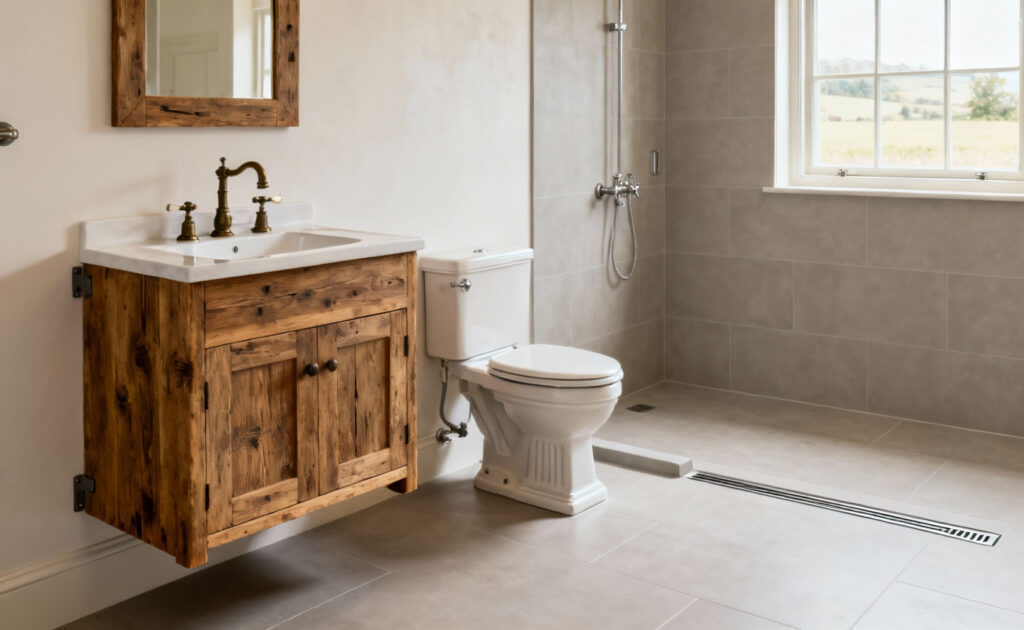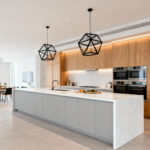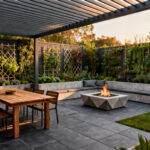Creating a home is, at its heart, an act of forecasting a life—every choice reflects not just an aesthetic preference, but a deeper set of values about how that life should be supported, nurtured, and celebrated. The most compelling bathrooms, particularly those that borrow from the honest farmhouse tradition, aren’t simply decorated; they are authored. They tell a story of longevity, of practicality, and of a quiet grace that anticipates our needs before we even know we have them. These 20 principles and ideas separate spaces that feel genuinely welcoming and authentic from those that simply adopt a rustic veneer.
In my work with universal design, I’ve learned that the most beautiful solutions are almost always the most inclusive. A farmhouse bathroom, rooted in a history of utility and built-to-last simplicity, is the perfect canvas for this philosophy. It’s about creating an environment where authenticity isn’t just seen, but felt—a space that extends an unspoken sense of calm and belonging to every person, regardless of their age or ability. Let’s move beyond the surface-level trends and cultivate a sanctuary that is truly designed for a lifetime.
Foundational Concepts: Cultivating Authentic Rural Elegance (Part 1)
Before we can innovate, we must understand the source. Authentic rural elegance isn’t about replicating a look from a magazine; it’s about channeling an ethos of purpose, resilience, and quiet beauty. This is where we lay the groundwork, choosing elements that resonate with a story of function and feel deeply, intuitively right.
1. Prioritizing Functional Harmony with Period-Appropriate Fixtures
The true soul of farmhouse design isn’t found in a catalog; it’s rooted in a history of practical purpose. Before it was an aesthetic, it was a way of life built on durability and honest function. So, when we begin, we must think like the original artisans: what here is built to last, to serve, and to be intuitively understood?
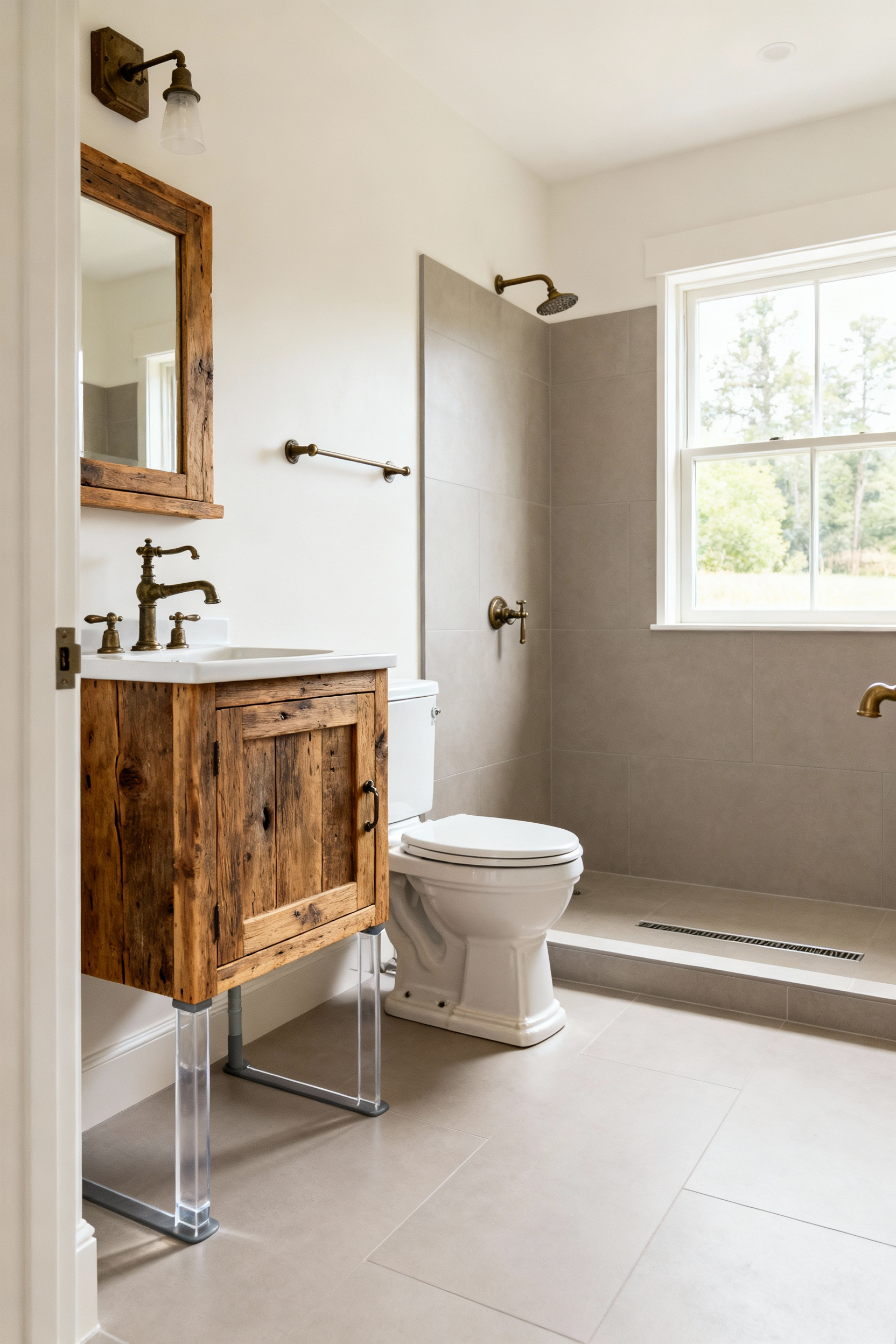
From my work in accessible design, I’ve noticed that the best designs, regardless of style, begin with this question. A beautiful clawfoot tub, for instance, isn’t just a visual statement. Its generous depth and embracing shape offer a genuinely superior bathing experience, a principle that speaks directly to the core of universal design—comfort and support for every body. A robust pedestal sink or a simple, sturdy bridge faucet feel good in your hands; they communicate reliability. We can find modern versions of these classics with updated efficiencies, but their form should honor their hardworking origins.
2. Integrating Timeless Materials for Tactile Authenticity
A space truly comes alive through touch. The soul of a genuine farmhouse bathroom resides in its tactile landscape, in materials that feel as good as they look and only get better with age. It’s a commitment to things that are real: wood, stone, metal, and ceramic.
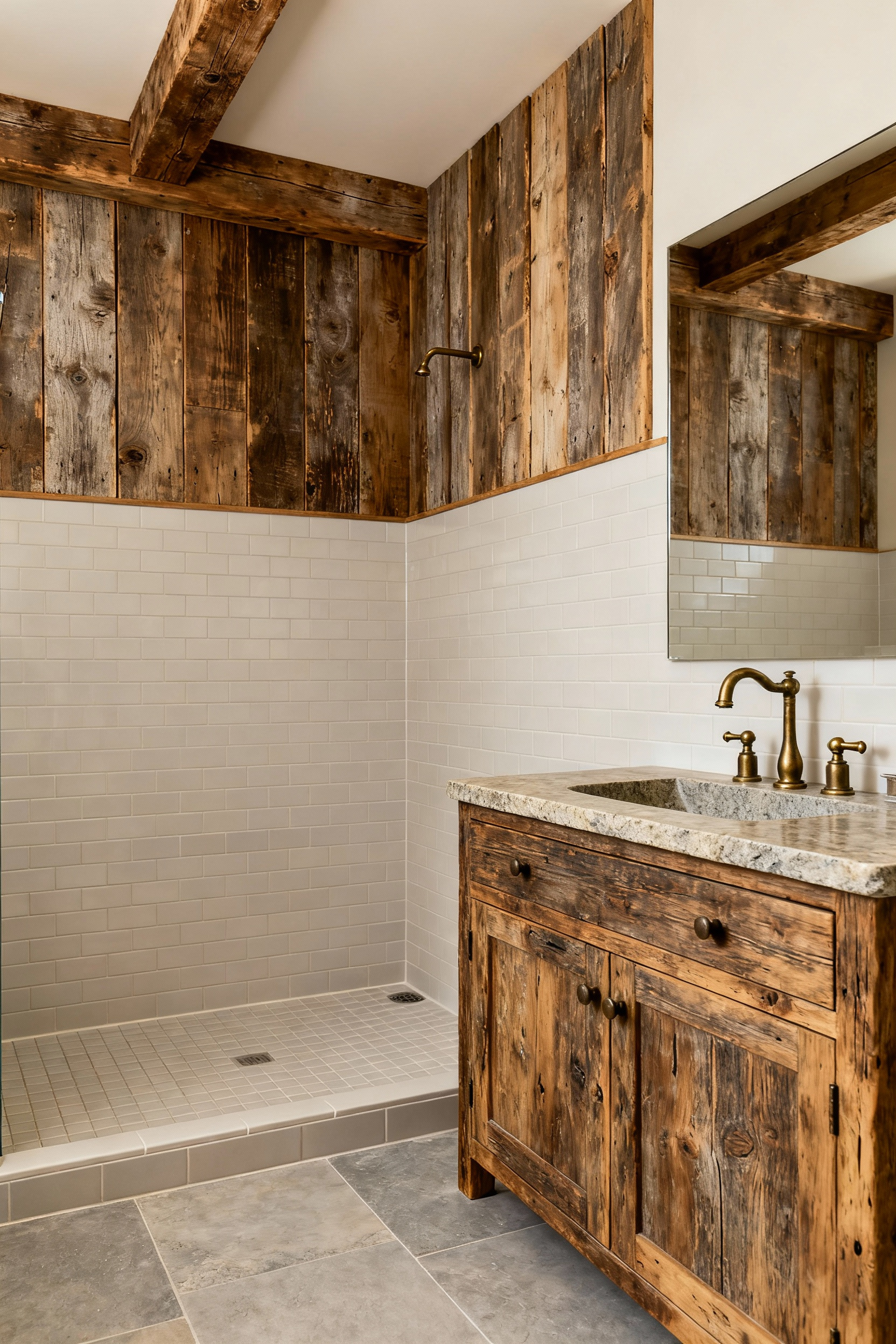
Consider the unparalleled warmth of reclaimed wood floors underfoot, where the slight imperfections tell the story of a former life. In my experience, these narrative details are what make a space feel like a home rather than a set. Natural stones like slate or honed marble provide a cool, grounding counterpoint, their surfaces subtly changing with the light. Cast iron, whether in a deep apron-front sink or a substantial tub, offers a reassuring solidity that speaks to generations of use. Choosing these honest materials is an act of designing for longevity, creating a space that doesn’t just endure but beautifully chronicles the life lived within it.
3. Mastering the Art of Rustic White Palettes for Serene Illumination
White in a farmhouse bathroom isn’t just a color; it’s a medium for light and serenity. But its mastery lies not in a flat, uniform application, but in a rich layering of textures. A purely monochromatic space can feel sterile, but a textured one feels like a sanctuary.

Imagine the subtle conversation between the soft, matte finish of shiplap, the gentle sheen of classic subway tile, the open weave of a linen shower curtain, and the distressed paint on a wooden vanity—all in harmonious shades of white and cream. This approach creates visual depth and a sense of coziness. Philosophically, a palette that minimizes visual noise allows the mind to rest, which is the ultimate goal of a personal retreat. This serene canvas also amplifies every drop of natural light, making the space feel more open and life-giving.
4. Curating Architectural Salvage for Narratively Rich Embellishments
To give a farmhouse bathroom a soul that can’t be bought off a shelf, you must invite history in. Curating architectural salvage is about finding those irreplaceable pieces that carry a story with them. An object with a past gives a new room instant gravity and character.
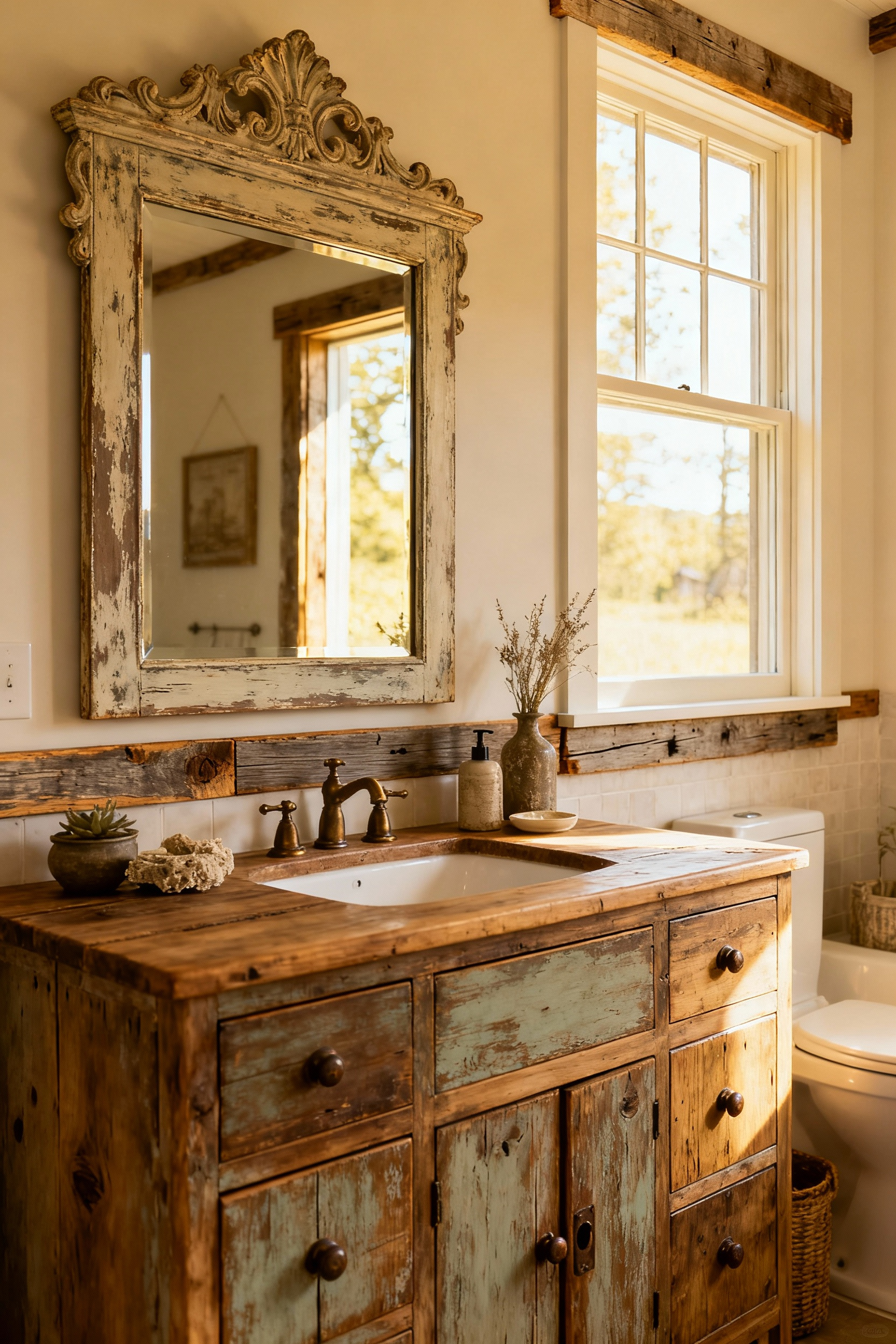
Think about a heavy, antique door repurposed on a sliding track—its original hardware and weathered paint lend a sense of permanence that a new door simply cannot. I once worked with a family who used an old window frame with wavy, imperfect glass as a partition for their shower; it was both beautiful and deeply personal. A vintage dresser, carefully adapted into a vanity, becomes a bespoke piece of furniture. This is also a quiet nod to sustainability, an inherent value in the farmhouse ethos. By thoughtfully integrating these salvaged treasures, your design transcends trends and becomes a personal archive.
Foundational Concepts: Cultivating Authentic Rural Elegance (Part 2)
Here, we deepen our understanding of these core principles. It’s about seeing how an aesthetic choice, when made thoughtfully, can become a profound act of care—creating spaces that are not just beautiful, but are fundamentally better for the people living in them.
5. Designing Barrier-Free Entrances with Threshold-Level Transitions
True hospitality in design means removing the obstacles we don’t even see. A barrier-free, or “zero-threshold,” entrance into the bathroom and shower is perhaps the single most impactful feature for creating a truly inclusive space. This isn’t just an accessibility feature; it’s a statement of effortless elegance and foresight.
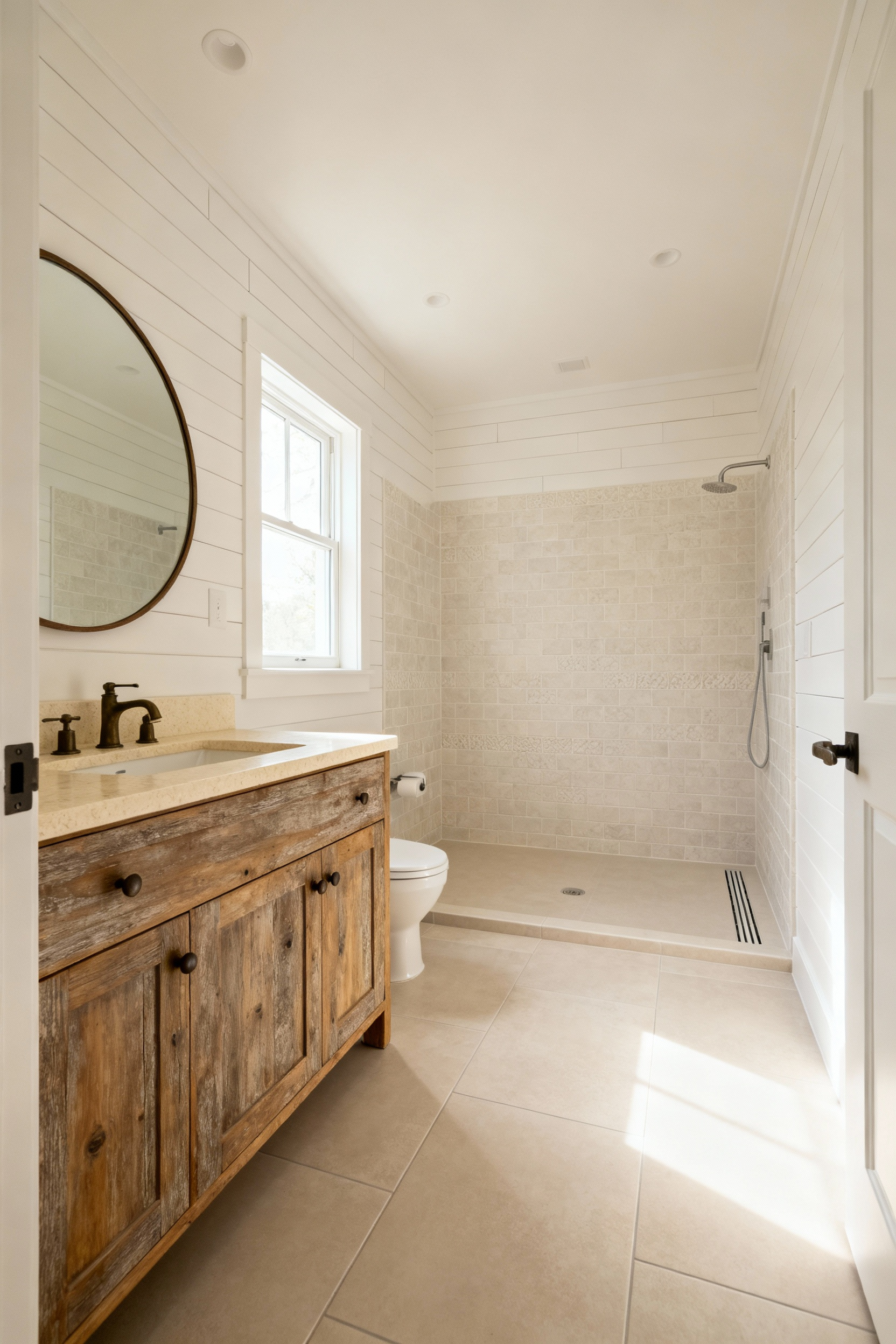
The seamless flow of a continuous floor surface—imagine slate or wood-look tile extending directly into a curbless shower—is both visually stunning and profoundly practical. It visually expands the room, creating an open, airy feeling that is the essence of modern farmhouse style. But more importantly, it eliminates a common trip hazard for everyone, from a toddler taking their first steps to an aging parent, or anyone using a walker or wheelchair. I learned early in my career that planning for these transitions from the very beginning, with proper subfloor sloping and a sleek linear drain, is what separates good design from truly great design. It’s an invisible detail that makes life palpably easier and safer for everyone.
Advanced Applications: Engineering Nuanced Inclusivity and Ergonomic Grace (Part 1)
Now we build upon that foundation, integrating modern wisdom and technology to elevate rustic charm into a state of ergonomic grace. This is where we engineer nuanced solutions that make a space intuitively easy and comfortable for every single person.
6. Optimizing Reach and Operability with Lever Handles and Smart Faucets
The small points of contact in a bathroom—the handles we turn, the faucets we touch—have a surprisingly large impact on our daily experience. Moving from traditional cross-handles to elegant lever handles is a simple upgrade with profound benefits. Levers can be operated with an elbow or the back of a hand, making them far easier for someone with arthritis, limited grip strength, or even just soapy hands.
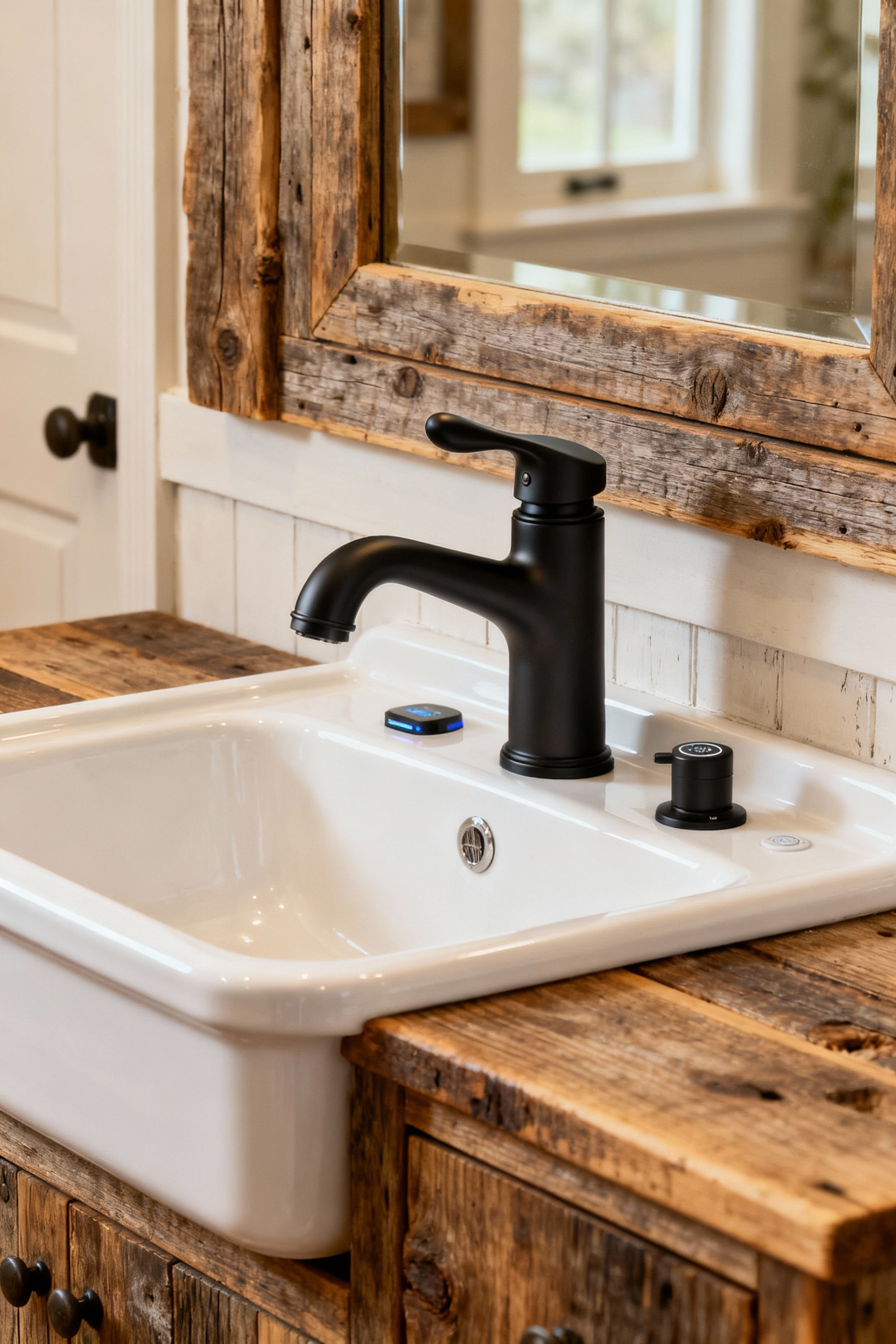
This is where traditional form meets modern function. You can find beautiful lever handles in oil-rubbed bronze or matte black that perfectly suit the farmhouse aesthetic. We can take this further with smart faucets. A touchless faucet isn’t just about hygiene; it’s about ease. Some models even allow for voice-activated temperature control, which is a fantastic safety feature for preventing scalds, especially for children or older adults. In my professional experience, the goal isn’t to create a futuristic bathroom, but to thoughtfully integrate technology that disappears into the background, silently making life safer and more dignified.
7. Implementing Curbless Showers for Seamless Mobility and Aesthetic Flow
We touched on the threshold, but the entire curbless shower is a masterclass in universal design. It is the single most powerful tool for future-proofing a bathroom while achieving a clean, expansive aesthetic that feels both modern and timeless. By removing the curb, you create one continuous, accessible plane.
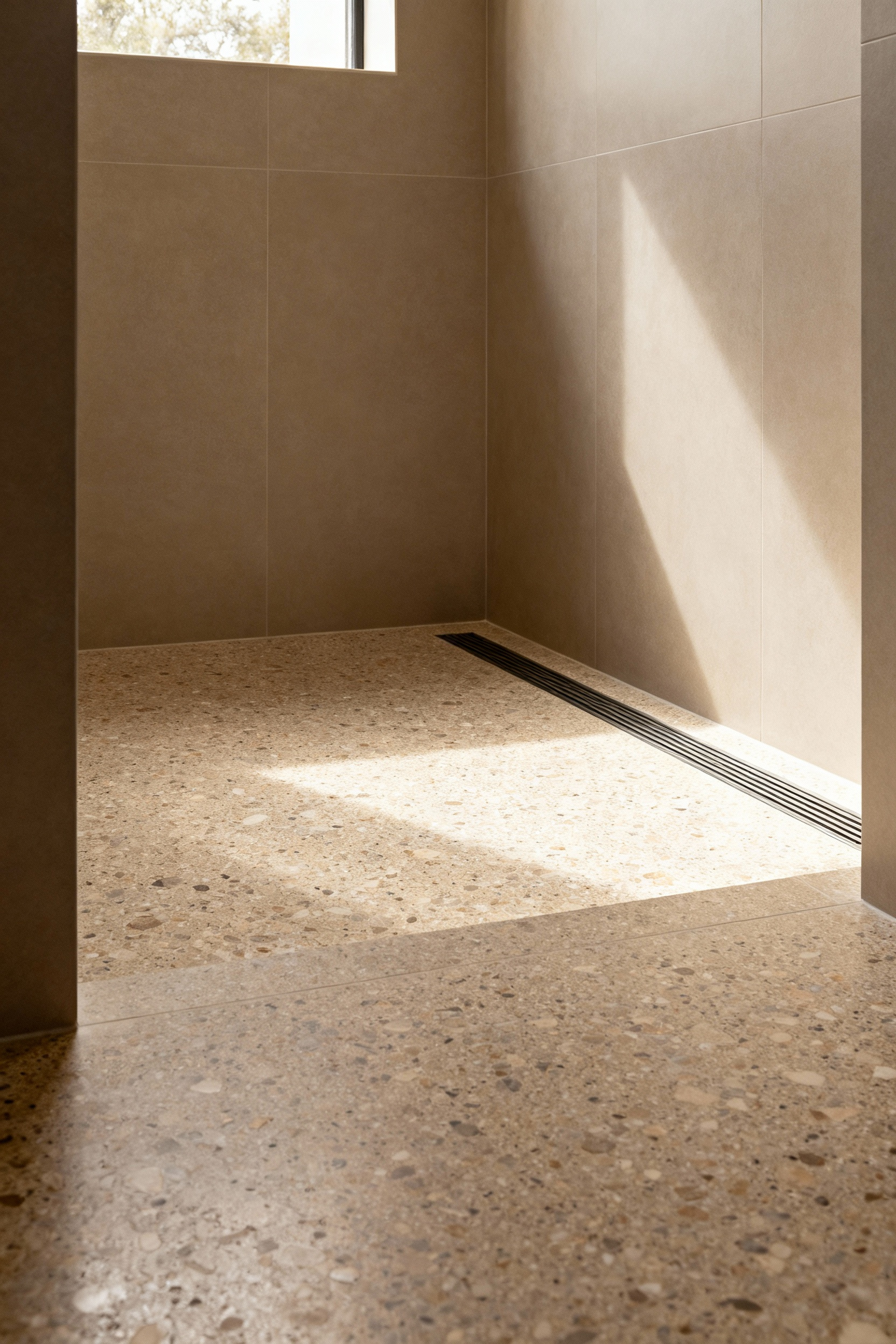
From a design standpoint, this creates an unbroken line that makes the entire bathroom feel larger and more serene—a perfect fit for the uncluttered farmhouse vision. You can run beautiful, large-format tiles straight through the space for a cohesive look. What I tell my clients is to think of it not as a feature for “disability,” but as a luxury of convenience. It’s easier to clean, it feels spa-like, and it ensures that the shower remains usable and safe for anyone, at any stage of life, from a star athlete with a sprained ankle to a grandparent visiting for the holidays.
8. Crafting Multifunctional Storage Solutions for Accessible Daily Living
Farmhouse design has a wonderful affinity for honest, freestanding furniture and open shelving. This provides a fantastic opportunity to design storage that is both beautiful and exceptionally accessible. True functionality means everything has a place, and every person can reach what they need without strain.
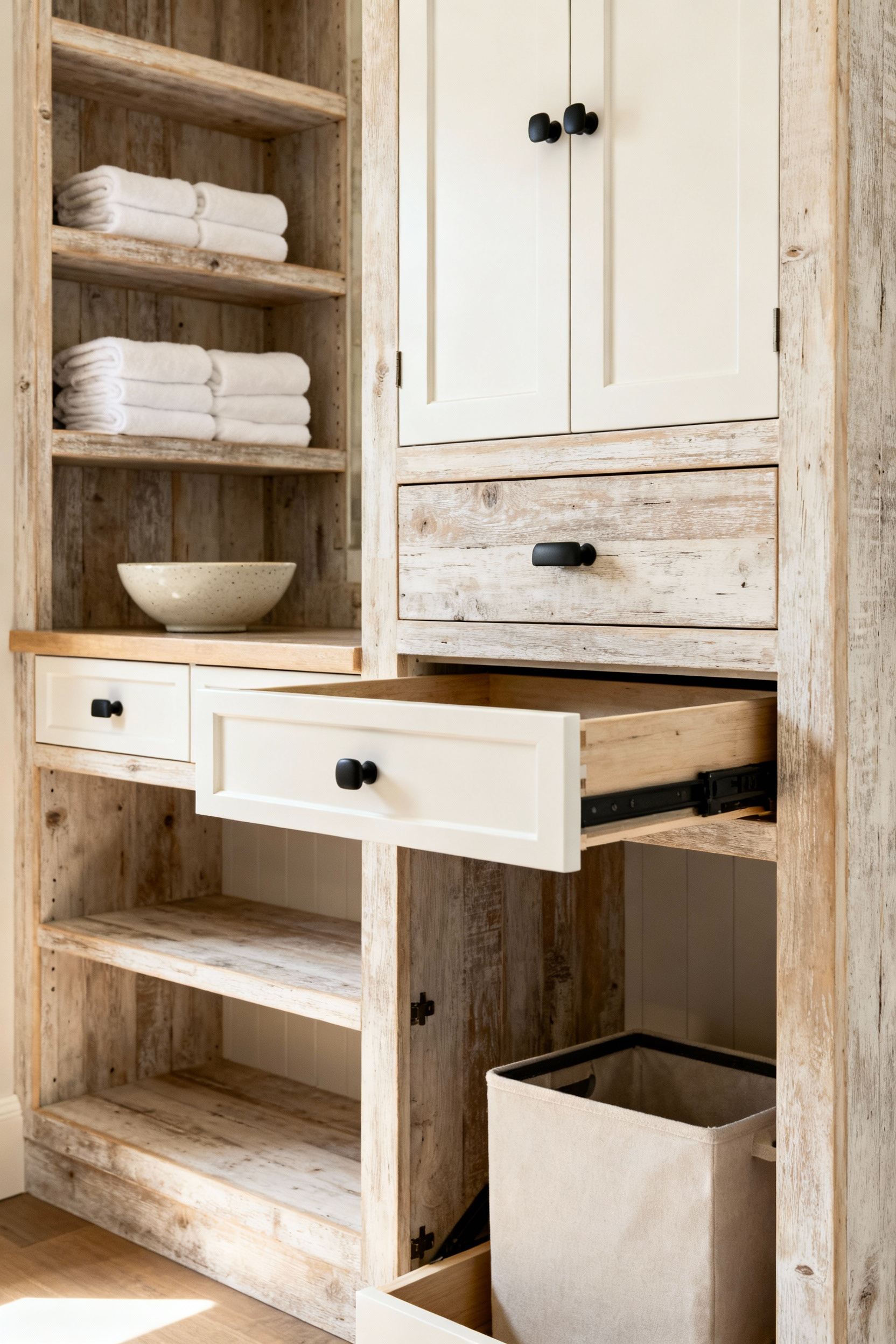
Instead of deep, dark cabinets, consider a vanity with large, full-extension drawers that present their contents to you. This is far more ergonomic than crouching and rummaging. Open shelving can be installed at varied heights—lower shelves for towels or items children can reach, and mid-level shelves for daily essentials. What really gets me excited is seeing an antique apothecary cabinet or a rustic rolling cart repurposed. The cart can be moved where it’s needed most—next to the tub during a bath, or beside the toilet—adapting the space to the user’s immediate needs. This is design that works with you.
9. Strategically Deploying Non-Slip Surfaces Without Compromising Visual Cohesion
Safety should never feel like a sterile, institutional compromise. In a farmhouse bathroom, safety can and should be beautiful. The key is to strategically choose surfaces that offer excellent traction while enhancing the rustic, natural aesthetic.
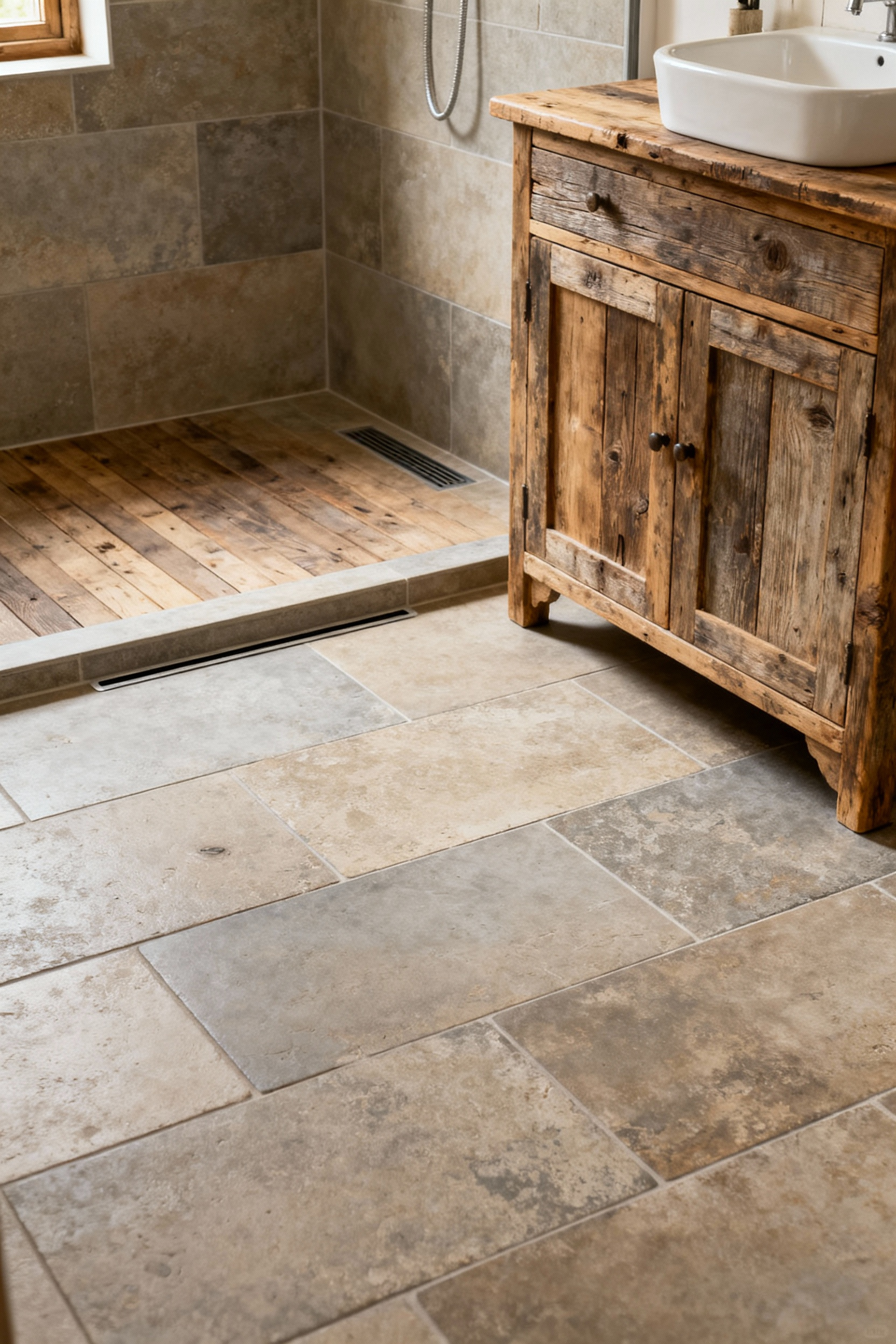
Forget the clinical-looking bath mats of the past. Today’s market offers gorgeous porcelain tiles with subtle texturing that mimics wood grain or natural stone, all while providing a high coefficient of friction for slip resistance in wet areas. I’ve seen this play out beautifully where a honed, rather than polished, stone is used. The matte finish feels wonderful underfoot and offers better grip. For shower floors, smaller mosaic tiles are an excellent choice because the additional grout lines naturally create more traction. This way, the safest choice is also the most visually interesting one, seamlessly integrating peace of mind into the fabric of your design.
Advanced Applications: Engineering Nuanced Inclusivity and Ergonomic Grace (Part 2)
We continue to refine our space, looking at the less obvious but equally critical elements that define a room’s comfort. Light, support, and flexibility are the invisible architects of a truly great bathroom.
10. Integrating Ambient and Task Lighting for Optimal Visual Acuity
Light is a sculptor. It shapes our mood, defines the functionality of a space, and is critical for safety. A well-designed farmhouse bathroom uses layers of light. Ambient light, the overall illumination, might come from a rustic central chandelier or a series of simple globe pendants, casting a soft, welcoming glow.
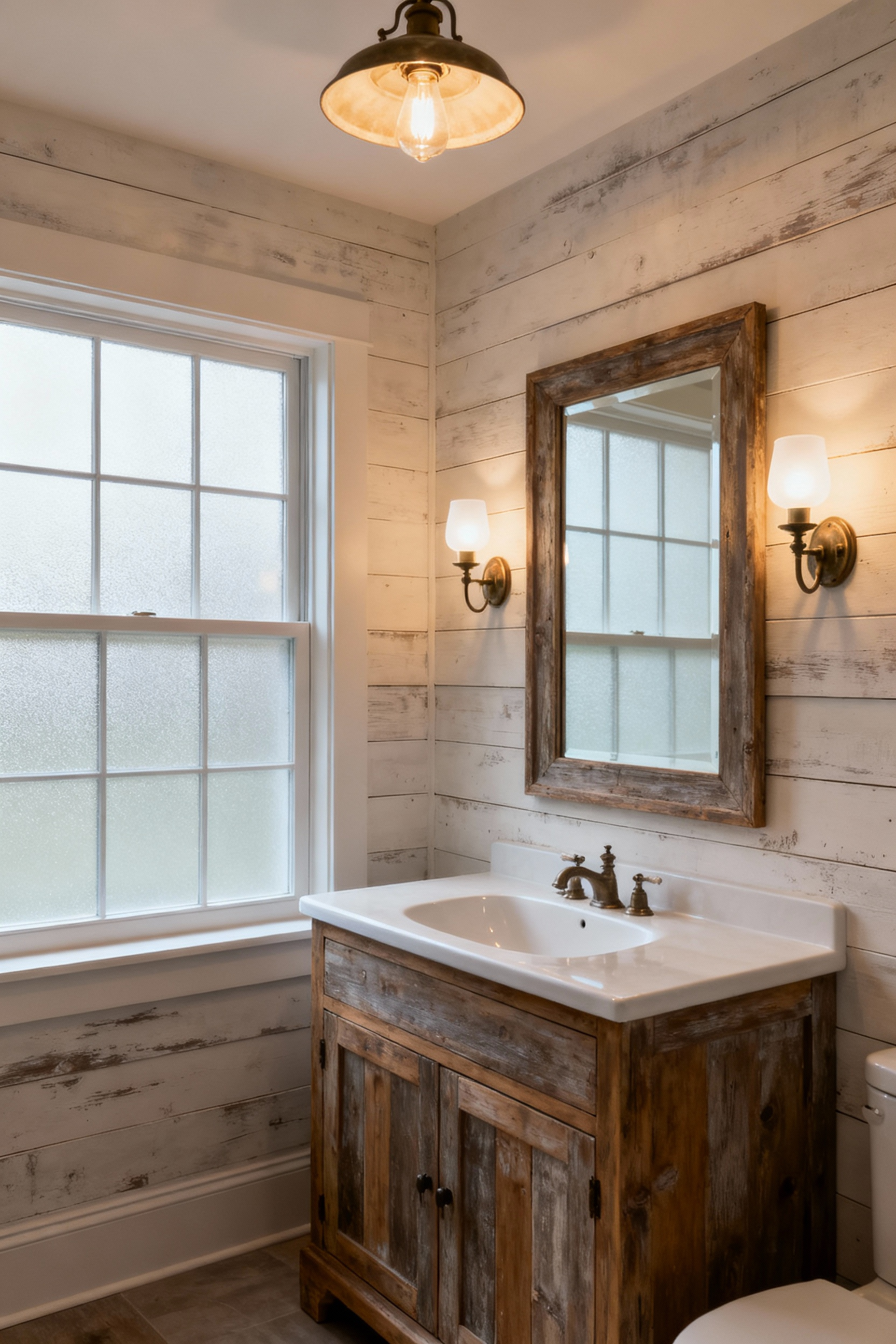
Task lighting is the workhorse. This is the focused light you need for grooming. I always advise placing sconces on either side of the vanity mirror, rather than overhead. This cross-illumination eliminates shadows on the face, which is a huge benefit for anyone, but especially for those with aging eyesight. And every light should be on a dimmer. This simple tool allows you to transform the room from a bright, energizing space in the morning to a soft, restorative sanctuary at night. It’s about giving you control over the atmosphere to support your well-being.
11. Specifying Grab Bars as Integrated Design Elements, Not Afterthoughts
Let’s reframe our thinking about grab bars. They are not a clinical intrusion; they are an elegant expression of care and foresight. When integrated from the start, they can be beautiful, functional elements that enhance the design. Forget the chrome-plated institutional look.
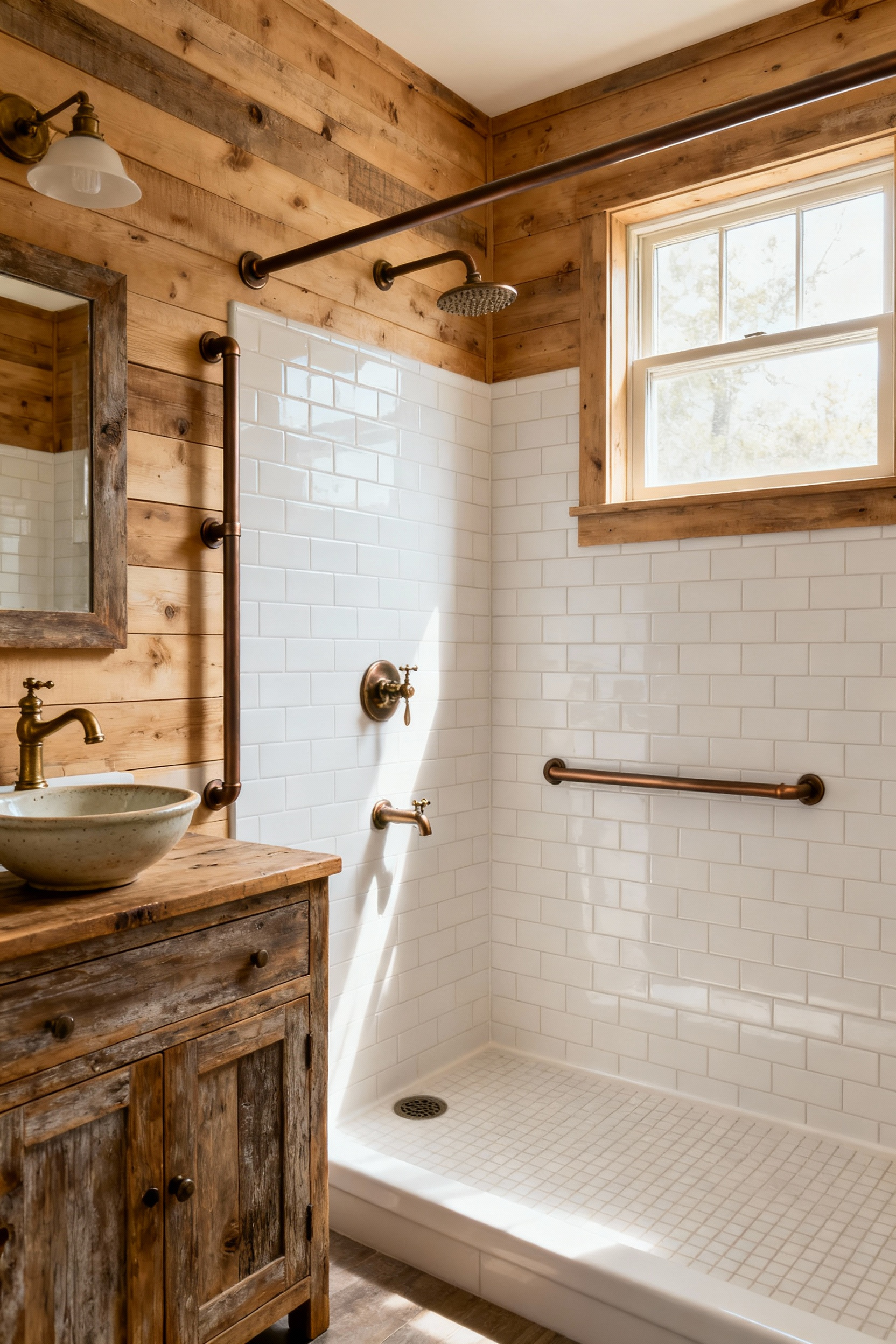
Today, you can find stunning grab bars in matte black, oil-rubbed bronze, and brushed brass that look like high-end towel bars or sophisticated design details. I’ve used gorgeous models that double as a toilet paper holder or a corner shelf in a shower. The key is to install them during construction so they can be properly blocked and anchored in the walls. Placing them thoughtfully—not just in the shower and by the toilet, but perhaps a short one to offer stability by the vanity—shows that you’ve designed a space that will support its occupants through all of life’s changes, gracefully and without fanfare.
12. Adapting Vanity Heights and Mirror Orientations for Multi-Generational Use
A single-height vanity is designed for a single type of user. But a multi-generational home requires more flexibility. One of the most elegant solutions I’ve seen is a tiered vanity. Imagine a main counter at a comfortable standing height with an adjacent, lower section. This lower space is perfect as a seated makeup area, and it’s also perfectly accessible for a child or a wheelchair user.
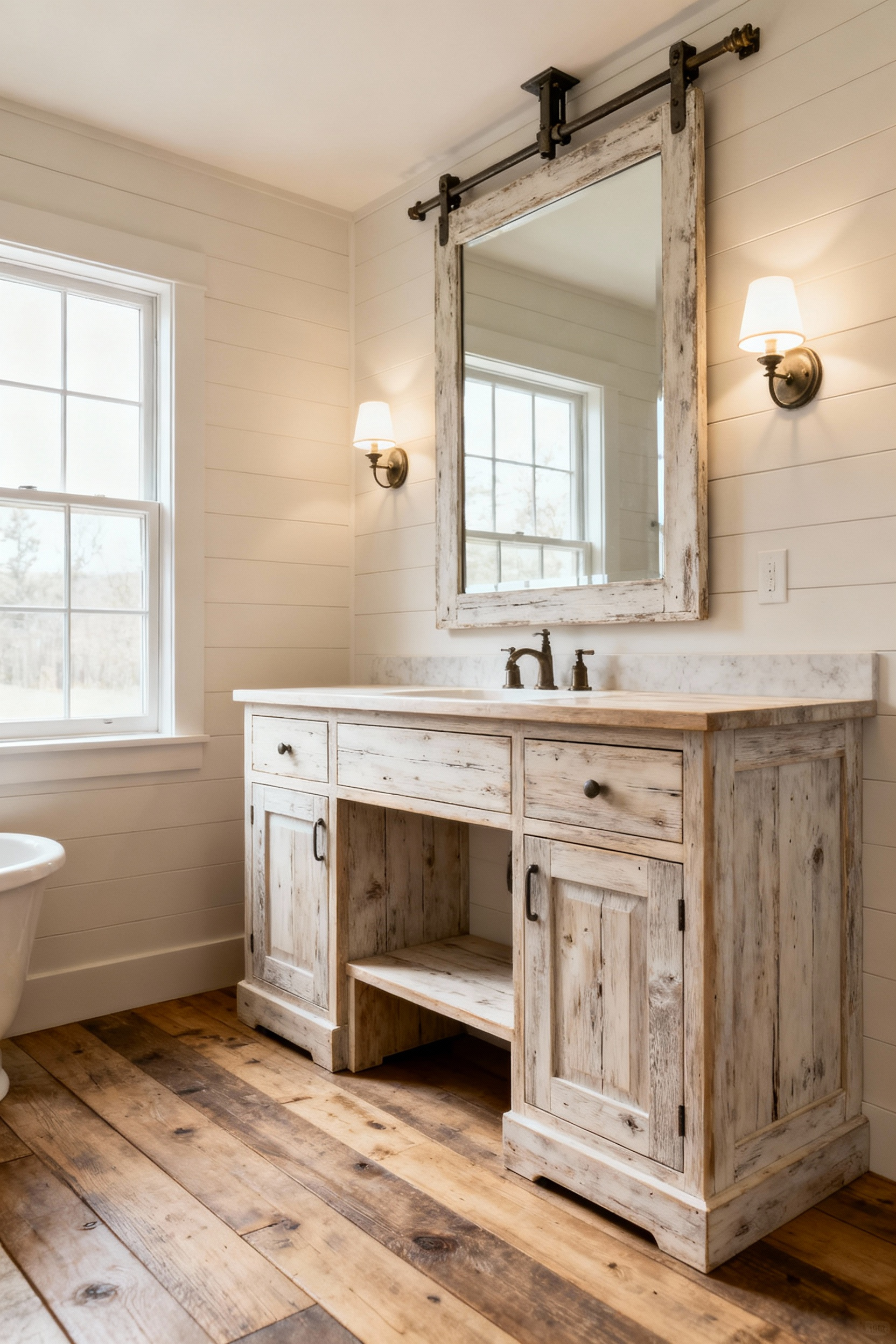
Paired with this, a simple pivot mirror is a game-changer. It allows any user, whether they are four feet tall or six, standing or seated, to adjust the reflection to their eye level. It’s a small, simple mechanism that fosters independence and dignity. These thoughtful adaptations are what transform a standard bathroom into a space that truly serves every member of the family, demonstrating that inclusive design is simply considerate, intelligent design.
Case Studies: The Experiential Craft of Materiality and Biophilic Integration
Now we explore the soul of the space. It’s one thing to choose materials; it’s another to craft an experience. This is about how the intentional use of natural elements can create a room that calms our nervous systems and connects us to something primal and restorative.
13. Leveraging Reclaimed Wood Textures to Evoke Ancestral Connection
Bringing reclaimed wood into your bathroom is like inviting an old soul into the room. Every knot, nail hole, and saw mark in a piece of salvaged barn wood tells a story. When you use it for a vanity, an accent wall, or open shelving, you’re weaving that history into your daily life.
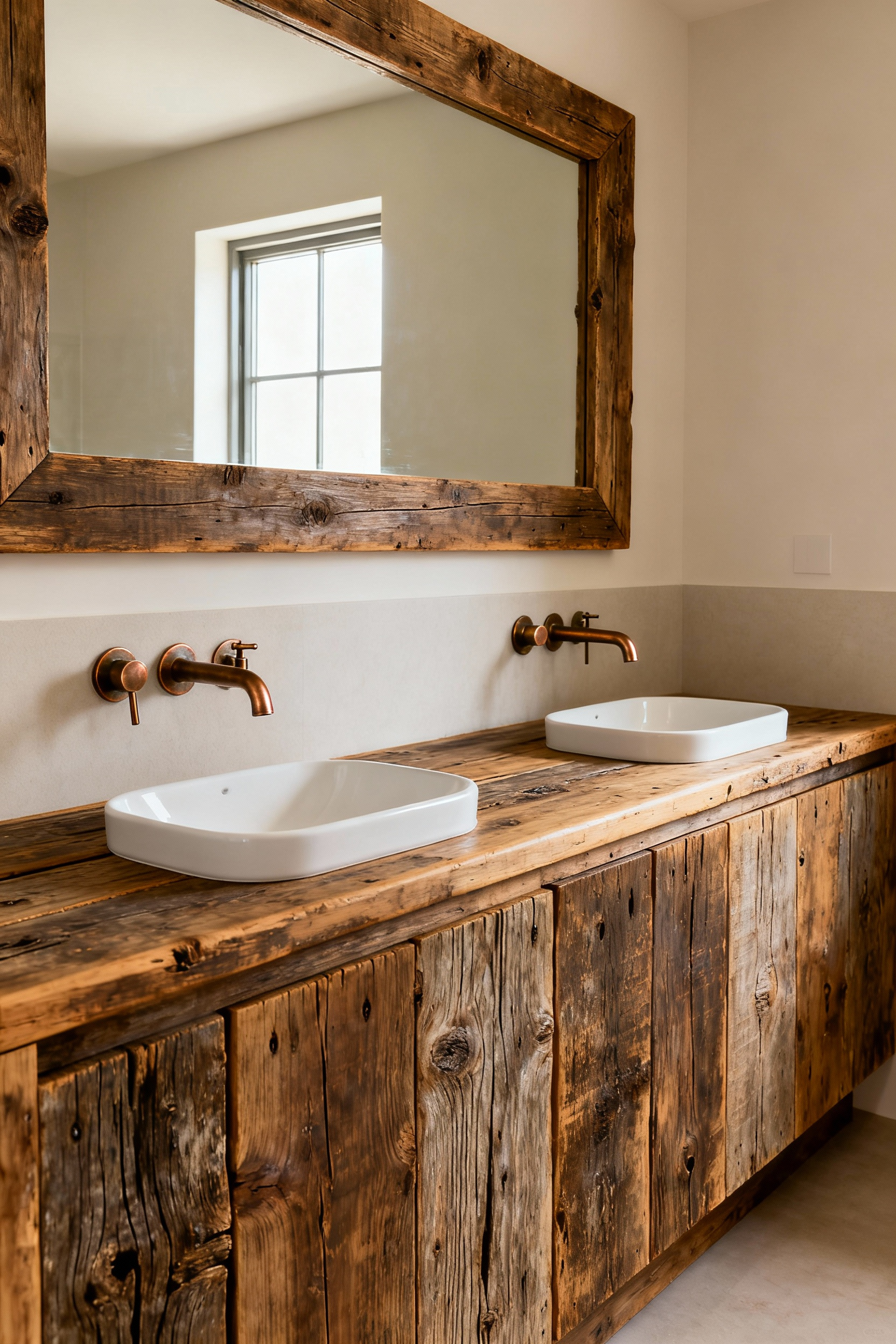
This does more than just look rustic; it provides a deep, grounding presence that new materials can’t replicate. It’s a tactile connection to the past and to the natural world. There’s an ancestral comfort in it. I’ve noticed clients are often drawn to these elements without quite knowing why. It’s because these materials feel authentic and enduring in a world that can often feel disposable. They speak to our deep-seated need for permanence and meaning.
14. Infusing Natural Light to Enhance Circadian Rhythm Alignment
Sunlight is a nutrient. Designing to maximize natural light in a bathroom goes far beyond simple illumination; it’s about aligning our home with our body’s natural rhythms. Abundant morning light can help wake us up and energize us for the day, while softer, afternoon light is more calming.
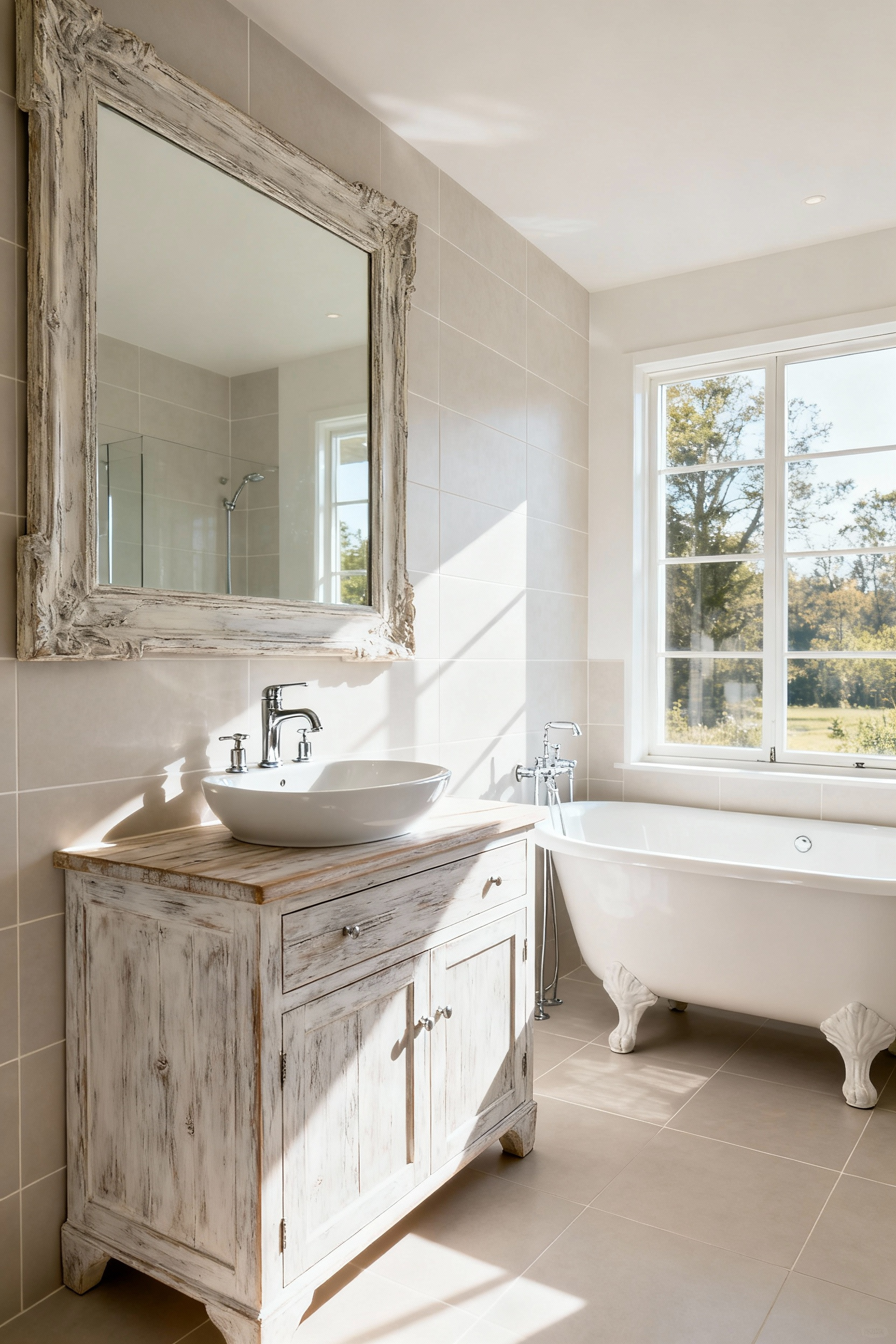
Strategically placing a large window—perhaps with frosted lower panes for privacy—can completely transform a bathroom into a vital, life-affirming space. Where a window isn’t possible, a skylight or a sun tunnel can channel daylight into the darkest corners. The way that natural light interacts with the textures in the room—glancing off a stone floor or warming a wooden vanity—creates a dynamic, living environment. This connection to the daily cycle of the sun is a core tenet of biophilic design, and it’s one of the most powerful tools for fostering well-being.
15. Integrating Subtle Aromatics Through Organic Plant Accents
Our sense of smell is powerfully tied to memory and emotion. A truly restorative bathroom should engage all the senses, including this often-overlooked one. Instead of artificial air fresheners, we can use living plants to create a subtle, therapeutic atmosphere.
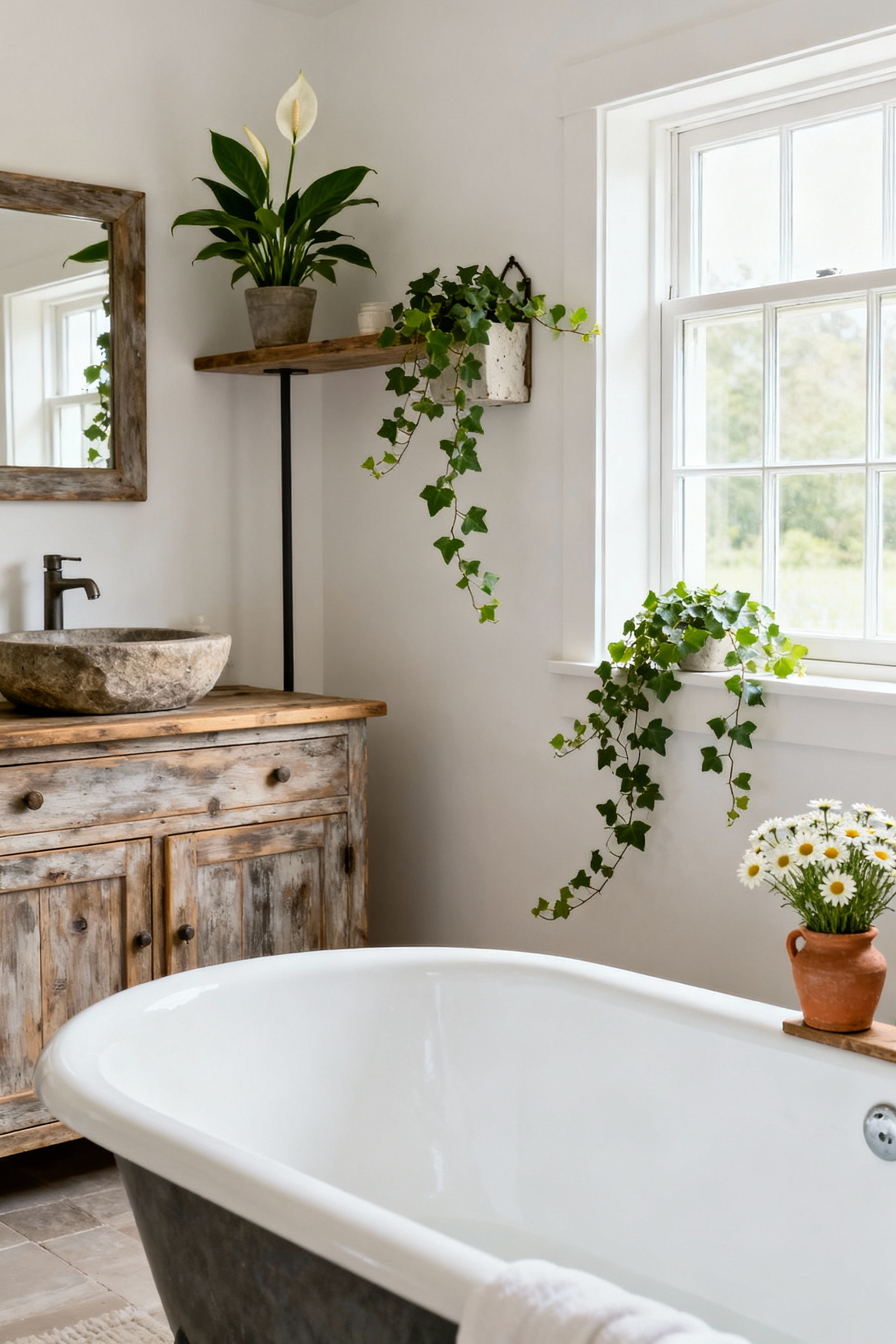
A bundle of fresh eucalyptus hanging in the shower will release its invigorating oils with the steam, creating a spa-like experience that can help clear the sinuses. A small pot of lavender on a windowsill can offer a calming scent, promoting relaxation. Plants like snake plants or ferns not only add a touch of green but also thrive in humidity and help purify the air. This isn’t just decoration; it’s a living, breathing element that contributes actively to the health and harmony of the space.
16. Exploring Patinated Metals for Rich Historical Depth and Durability
There is a profound beauty in materials that are allowed to age. Patinated metals—like unlacquered brass that deepens to a warm gold, copper that develops a soft verdigris, or oil-rubbed bronze that reveals highlights with use—tell the story of every touch.
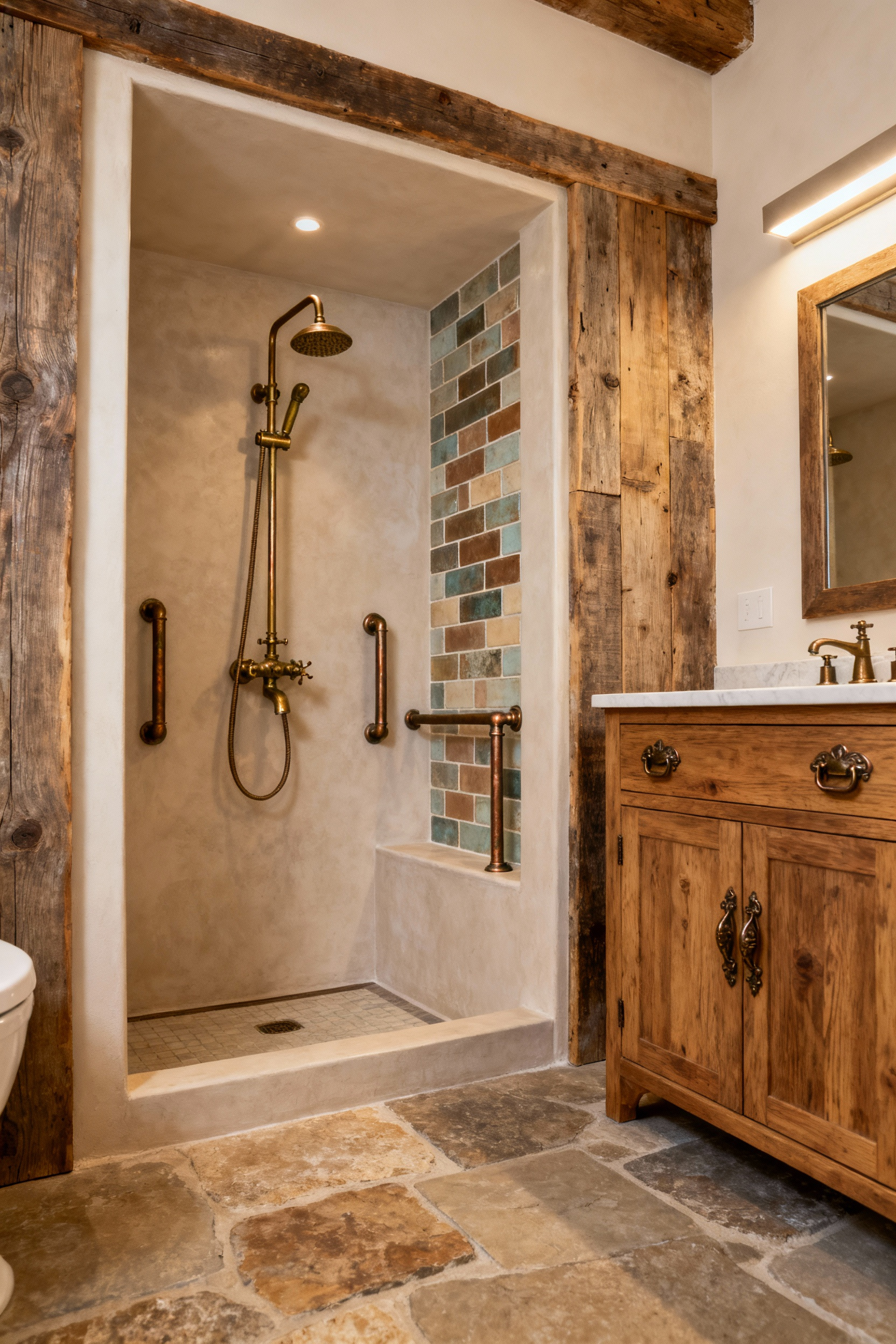
Unlike a pristine, factory-perfect finish, these “living finishes” evolve over time, developing a unique character that reflects how the space is lived in. This aligns perfectly with the Japanese philosophy of Wabi-Sabi, finding beauty in imperfection and impermanence. I often recommend these finishes for faucets, showerheads, and hardware. They provide a rich historical depth and a sense of permanence, grounding the lighter elements of the farmhouse palette and ensuring the space only becomes more beautiful and more uniquely yours with each passing year.
Philosophical Context: The Ethos of Purposeful Design and Enduring Value
At the deepest level, creating a farmhouse bathroom is about more than just style. It’s about embracing an ethos of purposeful, enduring design. This is where we consider the “why” behind our choices, creating a space that reflects our values and supports the life we want to live.
17. Embracing Imperfection: The Wabi-Sabi Aesthetic in Farmhouse Details
The true beauty of the farmhouse aesthetic lies in its humanity. It doesn’t demand perfection; it celebrates the small imperfections that signify a life well-lived. This is the heart of the Wabi-Sabi philosophy: finding grace in what is natural, handmade, and aged.
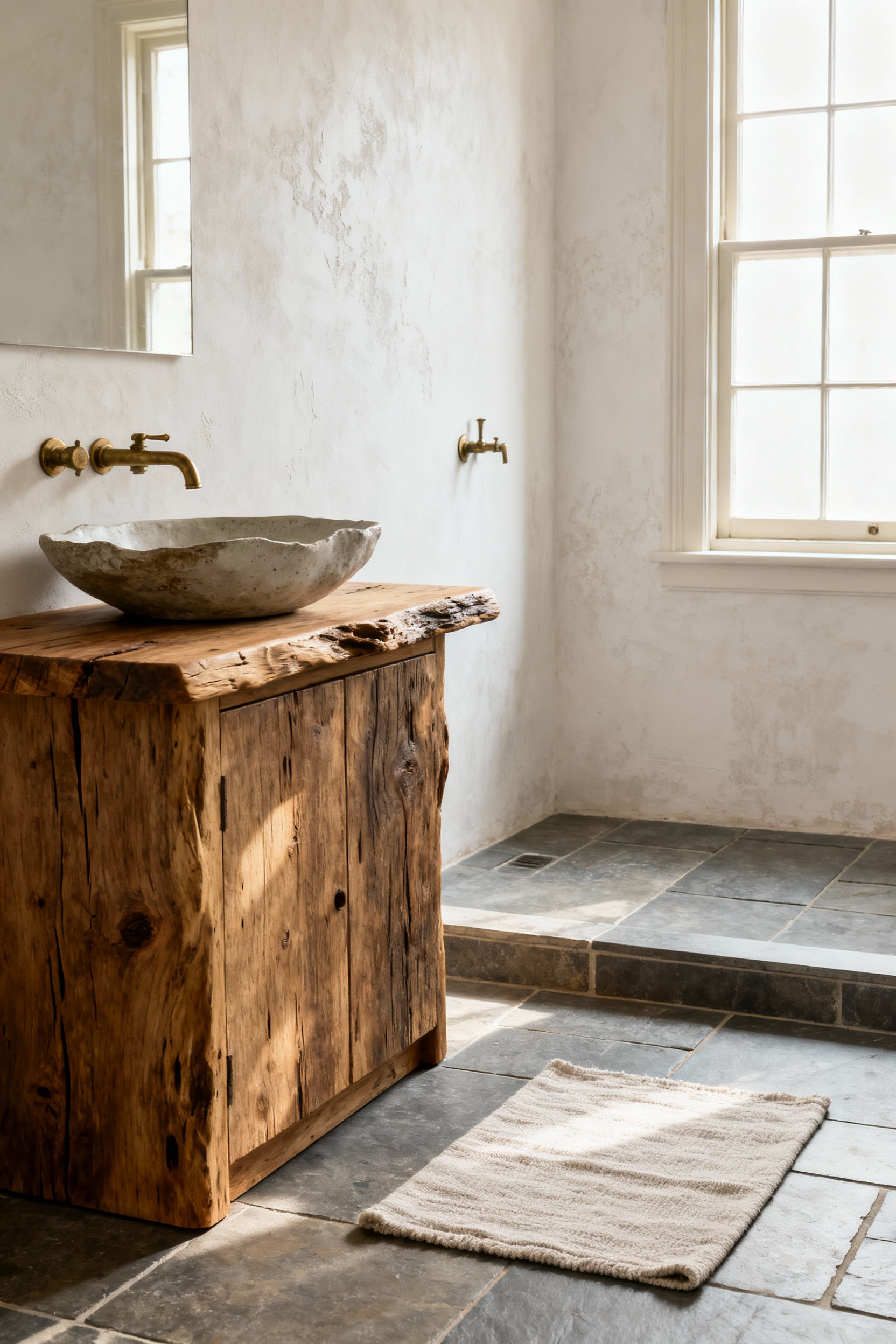
Think of hand-thrown ceramic tiles that are each slightly different, or a solid wood vanity with a visible grain and natural knots. It’s about choosing an antique mirror even if the silvering is slightly faded because that history adds character. From my professional experience, letting go of the need for sterile perfection is liberating. It allows us to create spaces that are warm, inviting, and forgiving. It’s an environment that says it’s okay to be real, to be comfortable, and to simply be.
18. Fostering Wellness Through Mindful Material Selection and Air Quality
A sanctuary should be a healthy space. This means being mindful of what our homes are made of. So many conventional building materials, from paints to adhesives to composite woods, can off-gas chemicals (VOCs) that degrade indoor air quality.
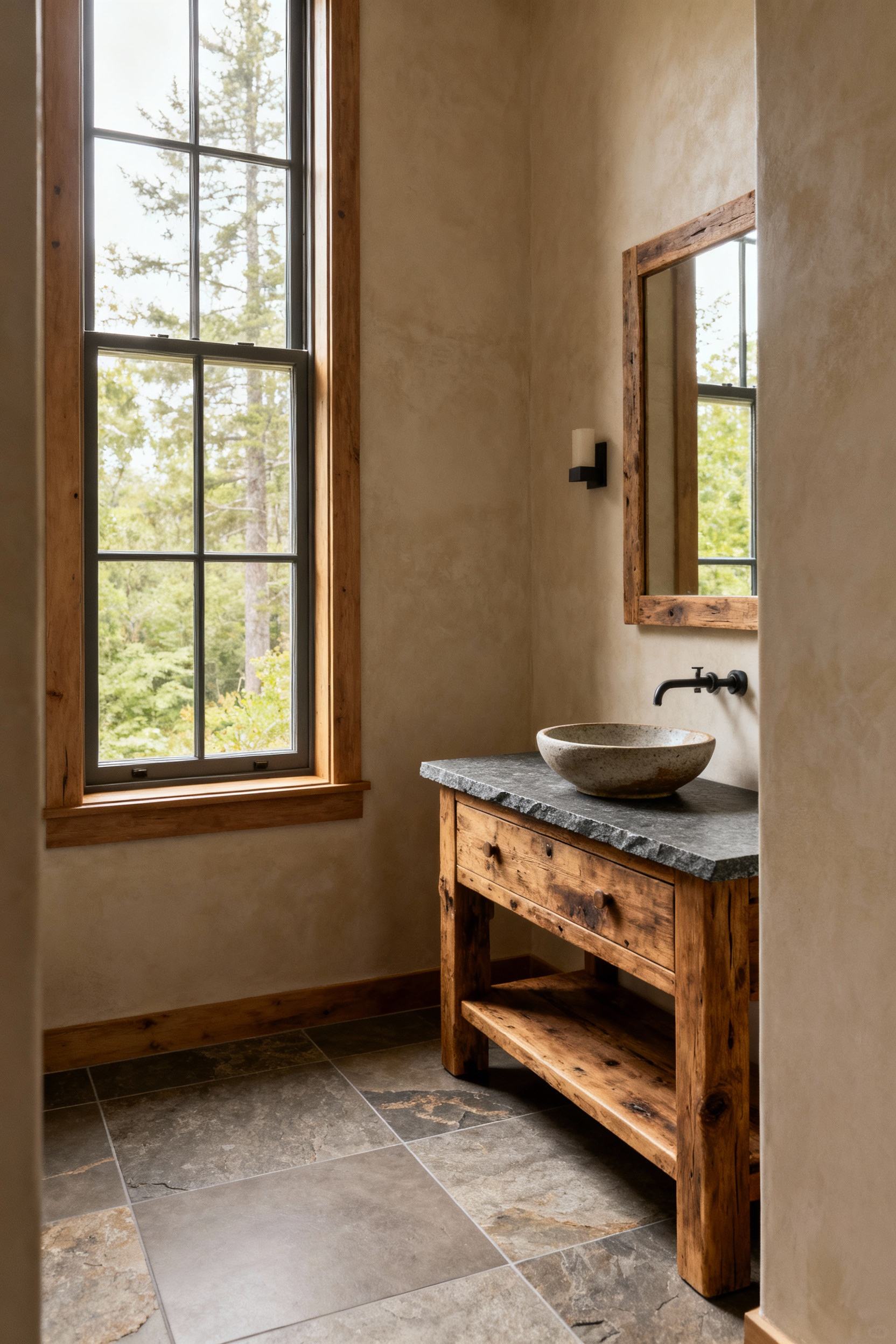
A truly thoughtful farmhouse bathroom prioritizes natural, non-toxic materials. This means choosing solid wood over particleboard, using zero-VOC paints, and selecting natural stone or ceramic tiles. It also means ensuring excellent ventilation to whisk away moisture and prevent mold growth. By making these mindful choices, we are creating an environment that actively supports our physical well-being. It transforms the bathroom from just a functional room into a space that genuinely contributes to our family’s health.
19. Cultivating Sensory Harmony for a Restorative Personal Retreat
A bathroom can be a place to rush through our morning routine, or it can be a place to restore our spirit. The difference lies in cultivating sensory harmony. It’s about considering how the space feels, sounds, and even smells, not just how it looks.
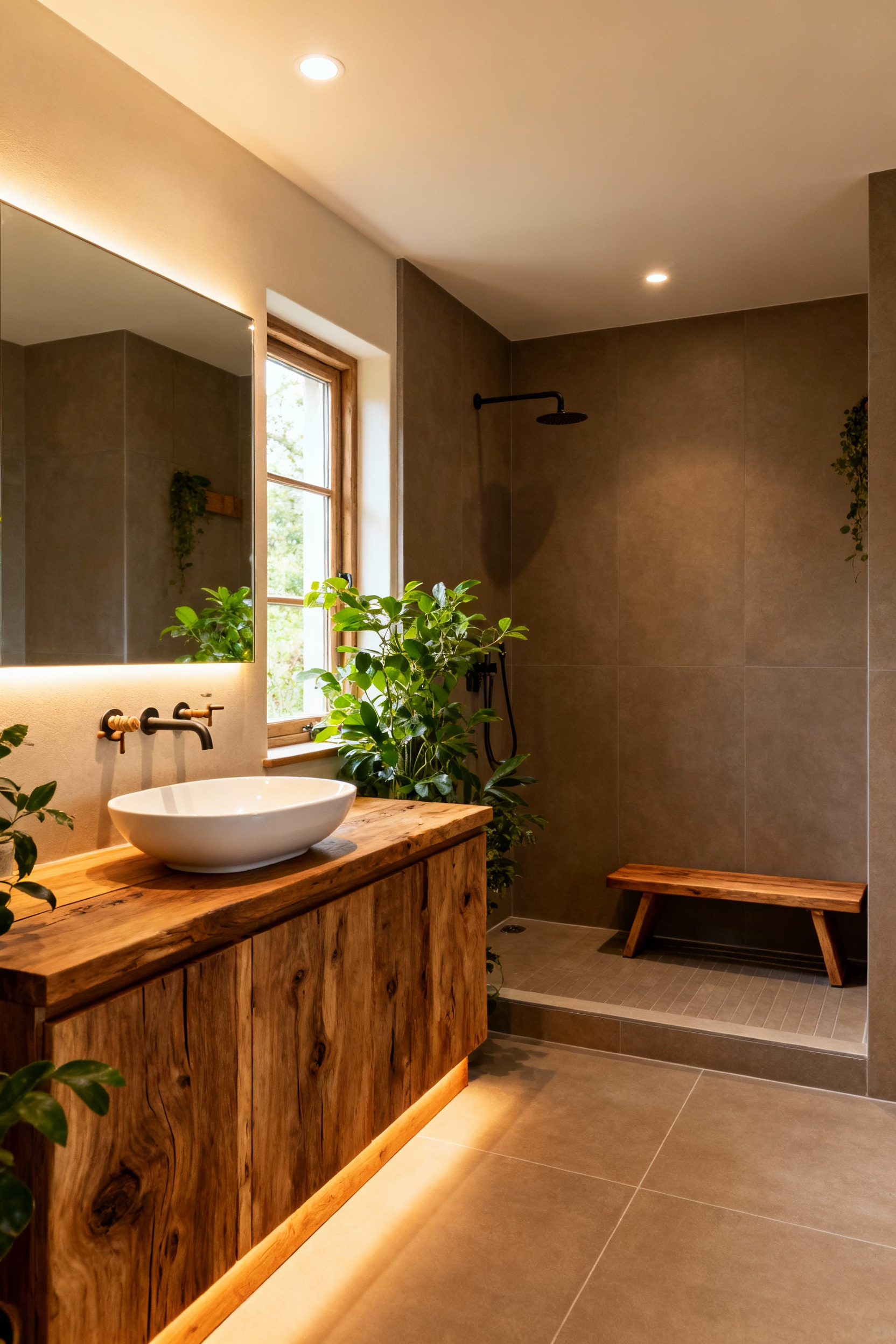
This means using soft, layered lighting, as we discussed, to create a calm mood. It’s about the tactile pleasure of a plush, natural-fiber bath mat underfoot, the cool smoothness of a stone counter, and the comforting weight of a quality linen towel. Consider the sound of a quiet exhaust fan, or the gentle sound of water from a rain showerhead. All of these details work together to create an enveloping experience that soothes the nervous system. It’s about transforming routine hygiene into a mindful ritual of self-care.
20. Projecting Long-Term Adaptability: A Sustainable Design Mandate
Ultimately, the most resonant farmhouse bathroom ideas are rooted in sustainability—not just in terms of materials, but in terms of time. The most sustainable design is the one you don’t have to tear out in ten years. This is about designing for long-term adaptability.
It means choosing classic styles and high-quality, durable materials that will stand the test of time. But it also means building in flexibility. By incorporating universal design principles—like a curbless shower, reinforced walls for future grab bars, and adaptable storage—you are creating a space that can evolve with you. This foresight is the ultimate expression of value. It ensures your bathroom will continue to serve you and your family safely, comfortably, and beautifully for generations to come.
Conclusion
So, where do you begin? Not with a shopping list, but with a question: Who is this home for, now and in the future? These ideas aren’t a checklist; they are invitations to think more deeply about what a home can truly be. A great farmhouse bathroom is far more than a style—it’s a sanctuary built on a foundation of empathy.
It’s a space that quietly says, “You are welcome here. You are cared for here. You can be at ease here,” no matter your age or ability. By weaving together the threads of authentic materials, inclusive design, and a philosophy of enduring value, you can create a bathroom that not only looks beautiful but also profoundly enhances the quality of your daily life. It’s my hope that you now feel empowered to craft a space that is a genuine reflection of thoughtful living—a sanctuary that will nurture you for years to come.
